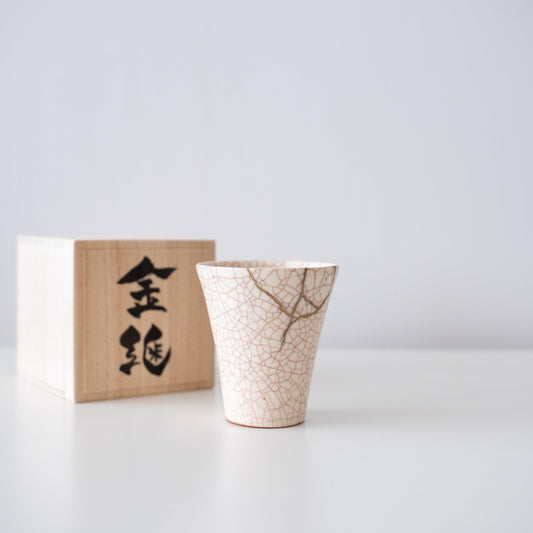Collection: Kintsugi Pottery
-

 Sold out
Sold outKintsugi Bowl "Iris Rose"
Regular price $756.00 CADRegular priceUnit price / per -

 Sold out
Sold outKintsugi Goblet "Gold Clay Crackle"
Regular price $514.00 CADRegular priceUnit price / per -

 Sold out
Sold outKintsugi Bowl Purple Nebula 01
Regular price $927.00 CADRegular priceUnit price / per -
Kintsugi Cup "Vermilion Crackle" 02 with a Paulownia Wood Box
Regular price $514.00 CADRegular priceUnit price / per -
Kintsugi Cup "Vermilion Crackle" 03 with a Paulownia Wood Box
Regular price $514.00 CADRegular priceUnit price / per
Recently Viewed Products
Kintsugi Pottery
The aesthetics of Kintsugi, closely aligned with the Japanese philosophy of Wabi-Sabi, embraces cracks and wear as markers of time, encapsulating a unique beauty. This philosophy in kintsugi pottery views breaking and mending as essential parts of an object’s or a person’s history. Rather than concealing flaws, kintsugi art highlights them, celebrating them as symbols of resilience and beauty.
Kintsugi pottery is an ancient Japanese art form where broken ceramics are repaired with lacquer mixed or dusted with gold or silver, transforming fractures into visible expressions of value. This mindset is deeply rooted in Japan, a land often shaped by natural disasters, reflecting a resilient culture that views overcoming adversity as a means to gain strength and beauty. Today, the meaning of kintsugi transcends physical repair, symbolizing the triumph over mental and physical hardships in life.
Millennium Gallery Japan is the exclusive online store offering kintsugi pottery by Taku Nakano, a renowned master of kintsugi art. Nakano, who holds kintsugi workshops in English in Tokyo’s Omotesando, attracts visitors daily who wish to learn kintsugi or purchase his works. His kintsugi pieces, embodying resilience and beauty, make meaningful gifts for individuals who have overcome personal challenges.
Kintsugi: The Japanese Art of Golden Repair
Kintsugi is a traditional Japanese restoration technique in which broken or chipped ceramics are repaired using lacquer and then embellished with gold, silver, or platinum powder. Its origins can be traced back to the Muromachi period (1330s-1570s), and it became widely popular with the development of the tea ceremony culture. Rather than concealing the damaged parts of a vessel, kintsugi highlights them, creating a unique beauty. It is considered more than just a repair technique; it's an art that breathes new life into broken ceramics.
History of Kintsugi: The Aesthetics of Wabi-Sabi and the Birth of Kintsugi Pottery
The origins of kintsugi pottery date back to the 15th century when a beloved tea bowl of Ashikaga Yoshimasa, a powerful leader, was broken. Unhappy with the plain metal staples used in its repair, he inspired the creation of kintsugi art, where lacquer and gold transformed the damage into a visible decoration. This technique became deeply intertwined with Japanese tea ceremony culture, symbolizing "wabi-sabi," the Japanese aesthetic of finding beauty in imperfection. "Wabi" embraces life's imperfections, while "sabi" derives from a sense of serene beauty in solitude. Kintsugi pottery exemplifies this philosophy, finding beauty in the fragile and transient.
Kintsugi represents a rebirth that starts with a broken vessel. It accepts the past rather than denying it, with gold decoration marking every scar. This philosophy extends beyond physical repair, conveying a deeper message about resilience and self-acceptance.
The Meaning and Philosophy of Kintsugi Pottery: Scars as a Testament to Strength, Imperfection as Beauty
Kintsugi meaning goes beyond repair, offering profound insights into life itself. By accepting flaws and turning them into something valuable, kintsugi art presents an aesthetic philosophy of resilience. Just as a broken vessel can be made beautiful through repair, our scars from life’s hardships can become symbols of our strength and individuality.
Modern society often prizes perfection, but kintsugi pottery introduces an alternative viewpoint: to embrace imperfection and find beauty within it. This approach encourages self-acceptance and inner healing, reminding us that beauty lies in resilience and growth.
Giving Kintsugi Pottery: A Meaningful Gift
People from around the world visit Taku Nakano’s Omotesando workshop to purchase kintsugi pottery as gifts for those who have overcome illness, injury, or hardship, or to symbolize reconciliation or deep bonds. For those who have faced difficulties, a kintsugi piece can serve as a powerful reminder of their strength.
Authentic kintsugi pottery, repaired with real lacquer and gold, is rare, even in Japan. However, Taku Nakano creates true kintsugi works by crafting vessels, breaking them, and then restoring them using genuine materials. His kintsugi art reflects Japan's cultural heritage and spirit, bringing hope and beauty to people worldwide.
How to Choose Kintsugi When choosing a kintsugi vessel, pay attention to the following points:
When selecting kintsugi pottery, consider the following:
- Type of Vessel: There are various types of vessels, including kintsugi cups, tea bowls, plates, and wall art.
- Type of Kintsugi: There are various techniques, such as crack mending, chip mending, and yobitsugi (joining different pieces together). Among them, yobitsugi, which requires the highest level of skill in kintsugi, is a masterpiece.
- Size: Choose the size of the vessel according to its intended use. Cup sizes are recommended as they are easy to give as gifts.
- Design: All kintsugi works are unique art pieces by Taku Nakano. No two pieces are the same.
Nakano’s kintsugi pottery has even received attention from the Georgian government for restoring cherished ceramics, bringing the philosophy of hope and resilience to people globally. His works, available exclusively at Millennium Gallery Japan, make meaningful gifts to celebrate life’s milestones or to honor someone who has endured hardship.
Kintsugi pottery is a remarkable expression of Japanese tradition and aesthetics. The kintsugi meaning of embracing imperfection and finding beauty within it resonates strongly, even today. Through kintsugi art, we hope you will experience Japan’s beauty and the richness of this profound philosophy.










